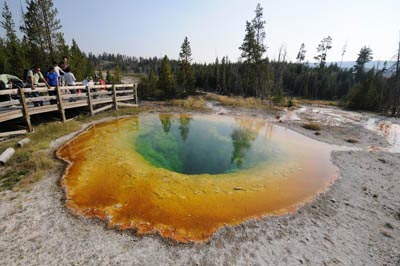Nature’s designs inspire research into new light-based technologies

“Nature has developed, very cleverly, some lessons on how to create the features that we desire in optical design,” said Joseph Shaw, director of the Optical Technology Center at Montana State University. “As we explore surfaces and structures at the nanoscale, we'll discover them.”
Some of those lessons were presented in San Diego in August during a conference called “The Nature of Light: Light in Nature” chaired by Shaw and Rongguang Liang of the University of Arizona College of Optical Sciences. The conference was part of SPIE Optics + Photonics, sponsored by SPIE, the international society for optics and photonics.
The conference is particularly relevant as the optics and photonics community prepares for the United Nations International Year of Light 2015, Shaw said. “Such lessons from nature not only remind us of how light-based technologies touch all of our lives and help solve challenges in energy, healthcare, communications, and other areas, but they also remind us to pause and appreciate the visual beauty found throughout nature.”
Shaw, whose research as a professor in electrical and computer engineering involves developing optical sensors for applications ranging from imaging of clouds to laser-detection of fish, said that observing how nature solves problems is particularly helpful for optical designers and engineers working with very small structures.
Insect wings that absorb all of the visible light spectrum and iridescent shells, for example, each possess optical surfaces that might find design applications one day, perhaps as camouflage.
Some wings have antireflective cone-like structures of a few nanometers that absorb virtually the entire visible spectrum, a team from the University of Namur (Louis Dellieu, et al.) reported. In the grey cicada, absorption is a product of the distinctive shape of tiny surface cones.
Iridescence of the lining of mollusk shells was explored by a team from Colgate University (R. A. Metzler, et al.), who reported on the polarization effects of the lining, known as nacre, or mother of pearl. It consists of up to 30,000 layers of tiny calcium carbonate “bricks” — just 0.5 microns, or a 200th of the diameter of a human hair — held together by a “mortar” of organic chitin. Reflected light from the lining produces the shells familiar array of colors.
“We have the tools for nanoengineering and nanoexploration,” Shaw said. “We can do reverse engineering of the structures.”
Color of vivid blue pools, some as hot as 250 degrees Fahrenheit, at Yellowstone National Park in Wyoming and Montana has only little to do with reflection of sky light, a paper by Shaw and others reported. The blue comes from the scatter of particles in the water. The deeper the water, the more dominant the scatter and the richer the blue. Red, orange, and yellow colors of other pools are driven by varieties of microbes on the rock surfaces under the water and related to the temperature of water in each pool.
Applications of these findings could include using a color imager to infer information about such pools and their resident microbe communities and what causes their presence. This could connect with NASA-funded research, because of the similarity of Yellowstone microbes with possible early forms of life on Earth and other planets. Ongoing Yellowstone research is even exploring how these microbes might inspire development of alternative fuels.
Optical labs looking for higher-efficiency solar cells or light-emitting diodes (LEDs) might one day use genetic algorithms to streamline their work. A team from Namur University of Namur (Alexandre Mayer, et al.), noting that thinking through a design question could mean millions or billions of options to check, demonstrated that a genetic algorithm can quickly make many small changes. A lab might need to explore only a few hundred options instead of millions. The genetic algorithm would work the way natural evolution does: scanning all the possibilities and quickly narrowing down the search.
Among other topics, presenters discussed:
- A firefly-inspired structure for improving efficiency of LED lighting (Annick Bay, Alexandre Mayer; University of Namur)
- Insights from models involving the speed of light for learning about the geometry of space-time (James Cole, University of Tsukuba)
- Spider interactions with objects to learn about the structure of color and color-producing elements (Bor-Kai Hsiung, University of Akron)
- Fabricating nanostructures inspired by the blue Morpho butterfly wing, replicating the wing's color and water-repellent qualities (Radwanul Siddique, Karlsruher Institut für Technologie, et al.)
Conference proceedings are now in publication, with papers going up in the SPIE Digital Library as soon as each is approved.
SPIE is the international society for optics and photonics, a not-for-profit organization founded in 1955 to advance light-based technologies. The Society serves more than 235,000 constituents from approximately 155 countries, offering conferences, continuing education, books, journals, and a digital library in support of interdisciplinary information exchange, professional networking, and patent precedent. SPIE provided over $3.2 million in support of education and outreach programs in 2012.
Media Contact:
Amy Nelson
Public Relations Manager
amy@spie.org
Tel: +1 360 685 5478
Media Contact
More Information:
http://spie.org/x110126.xmlAll latest news from the category: Interdisciplinary Research
News and developments from the field of interdisciplinary research.
Among other topics, you can find stimulating reports and articles related to microsystems, emotions research, futures research and stratospheric research.
Newest articles

“Nanostitches” enable lighter and tougher composite materials
In research that may lead to next-generation airplanes and spacecraft, MIT engineers used carbon nanotubes to prevent cracking in multilayered composites. To save on fuel and reduce aircraft emissions, engineers…

Trash to treasure
Researchers turn metal waste into catalyst for hydrogen. Scientists have found a way to transform metal waste into a highly efficient catalyst to make hydrogen from water, a discovery that…

Real-time detection of infectious disease viruses
… by searching for molecular fingerprinting. A research team consisting of Professor Kyoung-Duck Park and Taeyoung Moon and Huitae Joo, PhD candidates, from the Department of Physics at Pohang University…





















